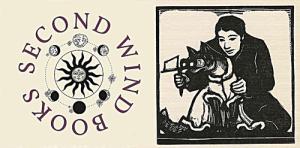More from Codex
The last day of Codex began with a memorable talk by the legendary British book artist Ron King. Ron showed slides of his work dating back to the 1950s. He got a long standing ovation; his wife, Willow, a sculptor, later said she was afraid he might start crying. He didn't, but it was a very moving experience to be in that audience and to contemplate this man's artistic genius. Like Picasso's, his mind is constantly moving forward to the point where now he is no longer making books per se, but carving seven-foot-high, book-like forms out of wood.
There was a different feeling the last day of the fair, a sense of urgency and seriousness of purpose. Though many librarians and collectors said they felt restrained by incipient budget cuts, they looked intently, and made wish lists. Those who could buy, bought. I heard that Stanford's special collections curator, Roberto Trujillo, spent $30,000, but I think he was the exception. Still, everyone agreed that the overall level of artistry was even greater this year than in 2007.
There was a different feeling the last day of the fair, a sense of urgency and seriousness of purpose. Though many librarians and collectors said they felt restrained by incipient budget cuts, they looked intently, and made wish lists. Those who could buy, bought. I heard that Stanford's special collections curator, Roberto Trujillo, spent $30,000, but I think he was the exception. Still, everyone agreed that the overall level of artistry was even greater this year than in 2007.
The closing dinner, at the extraordinary beaux arts Berkeley City Club,
built by Julia Morgan (who built the Hearst castle at San Simeon, among
other architectural wonders), had an esprit de corps unlike anything
I've seen in other professions. Abigail Rorer's charming book, "Mimpish
Squinnies" (Rorer as noted before is the subject of Richard Goodman's
next column) was presented to a Codex board-member, many inaudible
toasts were made, and Peter Koch got a well-deserved standing ovation.
Trujillo claimed to have visited every single table, but nobody else
could make that claim; the riches were too various, too great.
Today, some of the hungover and exhausted participants boarded a bus to tour Arion Press in San Francisco. Arion, as any fine press enthusiast well knows, was founded by Andrew Hoyem in 1974; it publishes some of the world's finest limited-edition books, often illustrated with original works by such artists as Jim Dine, Jasper Johns, Robert Motherwell, Wayne Thiebaud...the list goes on and on. The machinery at the press dates back to the early 20th century, and the drawers full of type were the envy of every printer in the group. The eminent Andrew Hoyem himself, immaculately dressed in suit and tie, gave us a tour, which felt a little bit like having Abraham Lincoln show you around the White House.Andrew showed us a broadside from a work in progress, a deluxe edition of Don Quixote, and while his mood seemed mostly somber, he became animated while reading a famous passage in which Cervantes pokes fun at a literary imposter. Though Arion is very much a working press, there is undeniably a shrine-like quality to the place. Many of Arion's great works are behind glass or on display shelves marked "Do Not Touch," with white gloves on the shelves. You have to wonder what will happen when Andrew Hoyem is gone. Will Arion become a museum?
Our last stop, the Center for the Book in downtown San Francisco, seemed to be saying yes. Here was an exhibiton of contemporary book art from South Korea and Japan, in which books were not books at all, but purely a point of artistic inspiration. Personally, and I think I speak for many of the participants today, I am not ready for books to stop being useful and hide behind glass.
Today, some of the hungover and exhausted participants boarded a bus to tour Arion Press in San Francisco. Arion, as any fine press enthusiast well knows, was founded by Andrew Hoyem in 1974; it publishes some of the world's finest limited-edition books, often illustrated with original works by such artists as Jim Dine, Jasper Johns, Robert Motherwell, Wayne Thiebaud...the list goes on and on. The machinery at the press dates back to the early 20th century, and the drawers full of type were the envy of every printer in the group. The eminent Andrew Hoyem himself, immaculately dressed in suit and tie, gave us a tour, which felt a little bit like having Abraham Lincoln show you around the White House.Andrew showed us a broadside from a work in progress, a deluxe edition of Don Quixote, and while his mood seemed mostly somber, he became animated while reading a famous passage in which Cervantes pokes fun at a literary imposter. Though Arion is very much a working press, there is undeniably a shrine-like quality to the place. Many of Arion's great works are behind glass or on display shelves marked "Do Not Touch," with white gloves on the shelves. You have to wonder what will happen when Andrew Hoyem is gone. Will Arion become a museum?
Our last stop, the Center for the Book in downtown San Francisco, seemed to be saying yes. Here was an exhibiton of contemporary book art from South Korea and Japan, in which books were not books at all, but purely a point of artistic inspiration. Personally, and I think I speak for many of the participants today, I am not ready for books to stop being useful and hide behind glass.
















